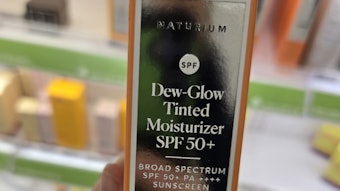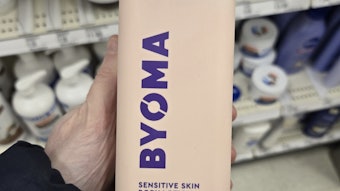Sensitive skin usually is described as a skin type showing higher reactivity than normal skin with responses to external factors ranging from itching and dryness to intense inflammatory reactions such as erythema or rash.1-3 This reactivity may vary according to seasonal changes.4 Anatomical modifications include a higher sensorial response, an enhanced immune responsiveness and diminished skin barrier function.1
Individuals with sensitive skin can exhibit a predisposition to skin barrier damage due to external factors such as detergents, and they have a tendency to hyperreact to topical agents. When skin biophysical parameters such as transepidermal water loss (TEWL), hydration, pH, sebum and colorimetric red color (an indication of erythema) are measured in individuals with sensitive skin, the values for TEWL, pH and colorimetric red value usually score higher, while values for hydration and sebum score lower as compared with non-sensitive skin individuals.3 What is of particular interest is that in sensitive skin, only the values related to hydration and colorimetric red color show statistical differences. This suggests a primary role for the skin barrier and its related permeability to trigger sensitive skin, since skin barrier impairment will increase irritant adsorption. The increase in erythema parameters due to increased vasodilation would be identified as a secondary influence due to increased irritant adsorption; i.e., the so called outside-inside theory. Since atopic dermatitis, or atopic dry skin in cosmetic terms, is also characterized by increased skin barrier permeability and erythema development, similarities arise between sensitive skin and atopic dermatitis—the latter being the extreme condition for sensitive skin.5
Skin Barrier, Cornified Envelope Proteins and Ceramides
Skin barrier function is controlled at the topmost layer of the stratum corneum (SC) by the cornified envelope, a highly insoluble and extremely tough structure formed beneath the cell membrane during terminal differentiation of keratinocytes. This envelope, with lipids on the outside, is characterized by cross-linked proteins. The main function of this barrier is to guarantee protection from the environment but also to avoid water loss.
Most skin barrier proteins have been identified, including: filaggrin, different cytokeratins, involucrin, loricrin, small proline rich proteins (SPRRs), S100 family and desmosomal proteins. These proteins regulate and dictate structural stability, mechanical resistance and elasticity, but they also are involved as the major amino acids source for the natural moisturizing factor to maintain skin osmolarity. Finally these proteins dictate the barrier thickness; for instance, SPRRs increase barrier thickness to protect from UV exposure.7
The recent identification of mutations in the genetic coding for some of these proteins would predispose individuals to develop abnormal cornified cell envelopes with subsequent predispositions to skin barrier damage.6 This damage manifests into atopic dry skin with different ranges of severity in sensitive skin individuals.
As stated, sensitive skin can manifest into atopic dry skin with consequent inflammation and eczema. For some time the cause of atropic dry skin was thought to relate to the immune system; however, the recent discovery of a primary epithelial barrier defect linked to the cornified envelope has anticipated the immunological cause. Filaggrin is a key protein that facilitates terminal differentiation of the epidermis and formation of the skin barrier, and it has been shown that two independent loss-of-function genetic variants in the gene encoding filaggrin are strong predisposing factors for atopic dermatitis. These variants are carried by approximately 9% of individuals of European origin.
Other proteins whose functionality could be affected by gene mutation are the SPRRs. Research has identified the gene coding for one of these proteins in the chromosomal region 1q21 and this region has been linked to atopic dermatitis in several studies.9 It is possible that most individuals have different levels and different activities of these cornified envelope proteins, expressed in their coding genes as polymorphisms. These differences that in the worst case lead to atopic dermatitis would determine the skin sensitivity level, i.e., the quality of the skin barrier.
Other markers that have been strongly linked to sensitive skin and atopic dermatitis are the ceramides. They are, in fact, decreased and their profile can be altered.10 The activity of specific enzymes in the SC that target ceramide production and degradation have been studied, revealing that levels for ceramidase, sphingomyelin (SM) deacylase, and glucosylceramide deacylase, all enzymes responsible for ceramides reduction, were increased in the presence of atopic dermatitis. This increase was, for some enzymes, found to be five times higher than in healthy skin.10,11 On the contrary, sphingomyelinase, which is essential to build up ceramides, was decreased and competed with SM deacylase for substrate.11 Altogether, the lack of ceramides combined with defective cornified proteins would synergize to weaken the skin barrier, causing water loss, penetration or exposure to irritants and consequent erythema development.
Formulations to Treat Sensitive Skin
Historically, formulations to treat sensitive skin have limited or avoided: common sensitizers and irritants; vasodilatory ingredients; preservatives; surfactants; emulsifiers; glycols; and fragrance. The formulator has to consider not only the ingredient composition, but also the relative concentration of the single ingredients. A higher amount of petrolatum will protect more than a lower amount, while an emulsifier with a different polarity can destabilize the lipid membrane, either by increasing the penetration of potential irritants (if nonpolar) or by creating holes (if very polar) between the membranes, resulting in water loss and membrane fragility.
From an experimental point of view, formulas were tested that contained minimal preservatives and no surfactants and showed the capacity to strongly ameliorate the sensitive skin phenotype after 8 weeks of application.2 On the other end, the addition of emollients and humectants as well as petrolatum for its immediate barrier-repairing effect decreased skin dryness, which is often observed in individuals with sensitive skin and that presents impaired barrier function, potentially leading to the development of atopic dry skin.12 Urea also showed interesting properties, reducing water loss and atopic dry skin susceptibility to SLES.12 More sophisticated formulas also enrich the lipid phase with ceramides and other membrane lipids. These formulas have been successful in improving atopic dry skin and decreasing water loss in children suffering from severe skin rash. The ultrastructure of the SC, treated with these formulas rich in ceramides, revealed extracellular lamellar membranes, which were largely absent in baseline samples.13
Conclusion: Stimulating
Barrier Ingredient Synthesis
Formulas for sensitive skin are often simple in design with a fewer number of ingredients in a petrolatum base; however, these are not as appealing from a sensorial point of view since they have little or no fragrance, no glycols and a limited amount of esters. They also have limited efficacy since functional ingredients such as retinoids and peptides are often avoided because they can be irritating. Formulas for sensitive skin can also be made more complex with the addition of ceramides or other membrane lipids, which often increases cost.
While traditional formulas for sensitive skin have tended to add barrier ingredients or moisturizing factors, what they miss is the addition of ingredients that would stimulate the synthesis of barrier ingredients such as ceramides or cornified envelope proteins. These novel ingredients would help the skin to build its own barrier defense from the inside-out instead of the outside-in. With this approach, formulators could develop a modern formula for sensitive skin. As an illustration,
Formula 1 gives an example of a formula not designed for sensitive skin, whereas Formula 2 shows a formula containing ingredients suitable for sensitive skin to reinforce the skin barrier.
The recent discovery of ingredients that stimulate the synthesis of cornified envelope proteins, or that decrease ceramidase activity while increasing sphingomyelinase, would help the formulator to design more sophisticated formulas to address skin barrier fragility associated proteins and lipids depletion or loss of activity. In particular, a complex based on oat hydrolysate has been shown to stimulate the synthesis of cornified envelope proteins such as filaggrin and SPRRs that are essential for skin barrier properties.14 When introduced at 3% into a cream with a low fatty phase and applied on the skin of 25 human volunteers, skin hydration increased by 66% after 2 weeks, and smoothness increased by 60% after 2 months of treatment. This was in comparison with the same cream excluding the complex, in a half-face comparison. These results indicated that stimulating barrier proteins results in increased hydration and better skin properties.
In another study, botanical extracts such as aloe ferox and American ginseng effectively decreased ceramidase and stimulated the activity of sphingomyelinase, an enzyme involved in ceramide degradation and synthesis.15 It might be of interest to see whether these extracts reduce skin irritation when applied in a product for sensitive skin.
Modern formulations for sensitive skin would likely include combinations of ingredients to stimulate the skin to produce more of its own skin barrier proteins, such as filaggrin and SPRRs, and ceramides. These ingredients would allow a different balance of previously used ingredients, possibly with reduction of petrolatum-based ingredients and exogenous ceramides.
References
1. ZD Draelos, Sensitive skin: Perceptions, evaluation and treatment, Am J Contact Dermat 8(2) 67–78 (1997)
2. N Muizzuddin, KD Marenus and DH Maes, Factors defining sensitive skin and its treatment, Am J Contact Dermat 9(3) 170–175 (1998)
3. S Seidenari, M Francomano and L Mantovani, Baseline biophysical parameters in subjects with sensitive skin, Contact Dermatitis 38(6) 311–315 (1998)
4. L Misery et al, Sensitive skin: Psychological effects and seasonal changes, J Eur Acad Dermatol Venereol 21(5) 620–628 (2007)
5. MJ Cork et al, Predisposition to sensitive skin and atopic eczema, Community Pract 78(12) 440–442 (2005)
6. A Ishida-Yamamoto and H Iizuka, Structural organization of cornified cell envelopes and alterations in inherited skin disorders, Exp Dermatol 7(1) 1–10 (1998)
7. E Candi, R Schmidt and G Melino, The cornified envelope: A model of cell death in the skin, Nat Rev Mol Cell Biol 6(4) 328–340 (2005)
8. CN Palmer et al, Common loss-of-function variants of the epidermal barrier protein filaggrin are a major predisposing factor for atopic dermatitis, Nat Genet 38(4) 441–446 (2006)
9. M Sharma, K Mehla, J Batra and B Ghosh, Association of a chromosome 1q21 locus in close proximity to a late cornified envelope-like proline-rich 1 (LELP1) gene with total serum IgE levels, J Hum Genet 52(4) 378–383 (2007)
10. MJ Choi and HI Maibach, Role of ceramides in barrier function of healthy and diseased skin, Am J Clin Dermatol 6(4) 215–223 (2005)
11. J Hara, K Higuchi, R Okamoto, M Kawashima and G Imokawa, High-expression of sphingomyelin deacylase is an important determinant of ceramide deficiency leading to barrier disruption in atopic dermatitis, J Invest Dermatol 115(3) 406–413 (2000)
12. M Lodén, Role of topical emollients and moisturizers in the treatment of dry skin barrier disorders, Am J Clin Dermatol 4(11) 771–788 (2003)
13. SL Chamlin et al, Ceramide-dominant barrier repair lipids alleviate childhood atopic dermatitis: Changes in barrier function provide a sensitive indicator of disease activity, J Am Acad Dermatol 47(2) 198–208 (2002)
14. F Gafner, K Schweikert K and G Dell’Acqua, Oat-based complex stimulates skin barrier protein synthesis and reduces skin aging, IFSCC Magazine 11(3) 217–223 (2008)
15. DW Koening and B Minerath, Ceramidase control: An approach to improving skin health,
J Cosmet Sci 59(4) 354–355 (2008)










